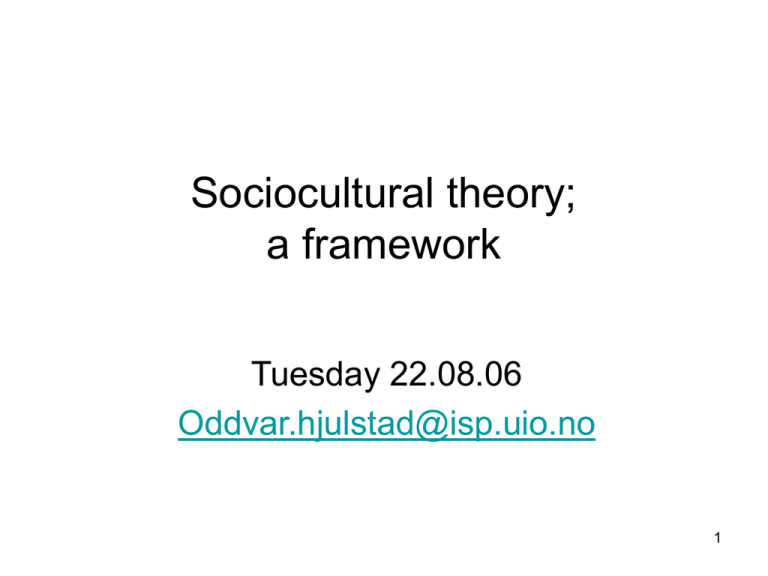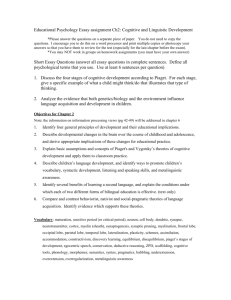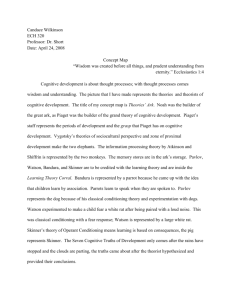Sociocultural theory A presentation for the International master
advertisement

Sociocultural theory; a framework Tuesday 22.08.06 Oddvar.hjulstad@isp.uio.no 1 SNE4130 Obligatory reading: 593 p. • Theoretical reading: » Cole, Michael. (1996). Cultural Psychology. Cambridge: The Belknap Press of Harvard University Press, Ch. 1 – 7: 220p. » Vygotsky, Lev. (1978). Mind in Society. Cambridge, Harvard University press. Chapter 4 and 6. 19 p. 2 SNE4130 Obligatory reading: 593 p. • Theoretical reading: » Rogoff, Barbara. (2003). The Cultural Nature of Human Development. Oxford, University Press, ch.1,2,3, & 7,8: 150p. 3 SNE4130 Obligatory reading: 593 p. • Klein, Pnina S. (Ed.). (2001). Seeds of Hope. Oslo, Unipub. Ch 1-4: 124p. • Rye, Henning. (2001). Helping Children and Families with Special Needs - A Resource-Oriented Approach. Article in Johnsen, Berit H. & Skjørten, Miriam D. (eds). Education – Special Needs Education: An Introduction. Oslo, Unipub.65p • Rye, Henning. (2005). The Foundation of an Optimal Psychosocial Development. In B. H. Johnsen (ed.). Socio-Emotional Support and Development of Learning Strategies (pp. 215 – 228) Oslo, Unipub - Oslo Academic Press. 13 p. 4 James, age 5, comes into the kitchen just as his mother has taken some cakes out of the oven. There is a loud, metallic ”Crack.” (extract from Wells 1999, xi) James: Who did that? Mother: I expect it was that tin contracting James: Which tin? Mother: The one with your pastery in James : Why did it make that noise? Mother: Well, When it was in the oven, it got very hot and stretched a bit. I’ve just taken it out of the oven, and it’s cooling down very quickly, you see, and that noise happens when it gets smaller again and goes back to its ordinary shape James: Oh! Was it a different shape in the oven? Mother: Not very different. Just a little bigger James: Naughty little tin. You might get smacked – if you do it again 5 Sociocultural perspective • Not a ”school” or ”particular” tradition, but consists of a range of different perspectives and theories (a inter- diciplinary field), but share some basic asumption on knowledge, learning and development • The task of sociocultural analysis is to understand how mental functioning is related to cultural, institutional, and historical context (Wertsch 1998) 6 Just some of the many faces of sociocultural theory Dialogism 7 Social antropology Ethnomethodology psychology Applied linguistics Education 8 Individualist & social philosophies & theories of learning (Gerry stahl 2004) Descartes (1633) Cognitivist Instructionism Rationalism Empiricism Kant (1787) Evidence-Based Instructionism Piaget Wittgenstein Husserl individual theories Wittgenstein Conversation Analysis Situated Cognition Habermas Communicative Action Heidegger (1927) Marx (1867) social theories Ethnomethodology Schutz Hegel (1807) Constructivism anthropology Vygotsky (1934) Social Practice Activity Theory 9 A dicplacement (?) of focus in cognitive research? • Traditional focus of cognitive psychology is to posit cognition as a fundamentally individual process. The assumptions is that human mental functions are located in individuals and can be modeled accordingly as mental entities such as memory systems, thought processes, and cognitive structures. • But this focus has shown great limitations, more and more cognitive researcher emphasizes social and cultural aspects of learning • Leading researchers within the sosio cultural paradigm have their background in cognitive psychology and cognitive linguistics 10 Learning theories Behaviorism: especially before 1950 (Pavlov, Thorndike, Watson, Skinner) Cognitive theories: especially after 1950 (”The cognitive revolution” (Bruner, Piaget) Sociocultural theories: 1990 (?) (Vygotsky, Bakhtin, Mead, Dewey,Engström, Wertch, Lave & Wenger, Cole, Rogoff, Säljö) 11 Cognitive theories: 1)Constructivism 2)Information processing • Cognitive theories first appeared last century, but were usurped by behavioural theories earlier this century, only to re-emerge as the dominant force again about 1950. • They are concerned with the things that happen inside our heads as we learn. They take the perspective that students actively process information and learning takes place through the efforts of the student as they organise, store and then find relationships between information, linking new to old knowledge, schema and scripts. Cognitive approaches emphasise how information is processed. 12 Cognitive theories: Constructivism • A reaction against behaviorism • Human do not automatically respond on exterior stimulus • Man do not ”strive for reward” but for ”meaning” • The focus turns to inner, higher mental processes Jerome Bruner Jean Piaget 13 Constructivism • Knowledge is organised in cognitive schemes • Learning take place in the form of assimilation (adding to the existing schemes) or accomodation (modifying the schemes) • Adaptions • Equilibrium 14 Experiments (”operational”) 15 Experiments (”operational”) 16 Piaget`stages of cognitive development 17 Piaget`s stages • Sensimotor stage (0-2Y) – Understand the world through senses and motor action – Develop object permanence • Preoperational stage (2-6Y) – Understands intiutive relations – Thinking is egosentric, dominated by perception • Concrete operational stage (6-12Y) – Can do logical operations – Understands reversibility – Can do conservation and classification tasks • Formal operational stage 12Y – Can do abstract and hypotetical reasoning – Can reason contrary to experience 18 Learning and cognitive development 19 Cognitive science: Information processing (Especially after 1970) • Symbolic information processing (Chomsky, Miller, Simon) • Emphasize the cognitive processes behind language skills, thinking and problemsolving • Unites neuro-sciense and ”computerscience” • The computer becomes a model for the human brain and mental proscesses. • Attention, storing, memory retrieval, ”chunking”… 20 The computation metaphor 21 The process of learning 22 ”Thinking or processing?” 23 The conduit model of communication The Conduit paradigme (Ledningsparadigme) Rommetveit (1996) Signal transmitted Sender Tankeinnhold Kodes i tale eller skrift Channel Signal received Receiver Dekoder ved å knippe Sammen lyder eller bokstaver til ord til setn. deler, til setninger osv. 24 Cognitive science: Some critical voices • Jerome Bruner (1990) (”The founding father of cognitive science”) – The cognitive revolution was expected to focus on meaning and meaning constructions, and be something more than just an improvment of behaviorism, and the reduction of minds to machines – The de-humanisation of our understanding of the human mind 25 Sociocultural epistemology • What is knowledge? • Where is knowledge? • How is knowledge created? • What is knowledge about? 26 How is knowledge created? (Epistemology) Social constructionism: Pragmatism: Knowledge is a product of constructions and conventions. Reality is negotiated Knowledge appear in interaction with objects in the world ”Knowing how” instead ”knowing that”. ”Truth” is not a criterion 27 Some sociocultural claims about human learning • • • • • Learning is mediated Learning is fundamentally social Learning is situated Learning is distributed Learning is participation in communities of practices 28 Mediated learning • • • • ”Psychological tools” ”Cultural tools” ”Mediational means” ”Cultural artefacts” – Language – Symbols – representations 29 Mediated action M (Artefakt) S (Subjekt) O (Objekt) Subjekt og objekt sees ikke kun som ”direkte” forbundet, men også som ”indirekte” Forbundet gjennom et medium som utgjøres av artefakter (Kultur) 30 In activity theory: 31 Learning is mediated Language: ”The tool of tools” • Language is the most important cultural tool avaiable to man – It is therefore of particular interest for studying processes of learning 32 Mediated learning Language-communication-learning • It is through communication that sociocultural resources are created, but there is also through communication that they are carried forth. • Thinking in the individual are forms of communication that the individual has met, appropriated and uses as resource in future situations (Säljö 2000) 33 Mediated learning Classification as artefacts (tools) The question, "What is it really?" "What is its right name?” is a nonsense question (…) one that is not capable of being answered. (...) When we name something, then, we are classifying. The individual object or event we are naming, of course, has no name and belongs to no class until we put it in one (…). What we call things and where we draw the line between one class of things and another depend upon the interest we have and the purposes of the classification.(...) Most intellectual problems are, ultimately, problems of classification and nomenclature. (Hayakawa, 1965, pp. 215-220) 34 Learning is fundamentally social • ”Any function in the child`s cultural development appears twice, or on two planes. First it appears on the social plane, and then on the psychological plane. First it appears between people as an interpsychological category, and then within the child as an intrapsycholgical category. This is equally true with regard to voluntary attention, logical memory, the formation of concepts, and the development of volition (Vygotsky 1981:163) 35 Learning is fundamentally social • ”Human mental functions are inextricable situated in social, cultural, institutional and historical context” (Wertsch 1991:86) 36 Learning is fundamentally social • Levels of analysis: – Ontogenetic development • Changes in the individual over the lifespan – Microgenetic development • Changes over the brief periode of time – Phylogenetic developement • Changes in evolutionary time – Sociohistorical development • Changes in culture, values, technology 37 Learning is fundamentally social • The Zone of Proximal Development (ZPD) is the distance between the actual developmental level as determined by independent problem solving and the level of potential as determined through problem solving under adult guidance or incollaboration with more capable peers. 38 Learning is fundamentally social • ZPD cont.: • Lefrancois (1994): Take, for example, two five-year-old children, who can both, under normal circumstances, answer questions that other average five-year-olds can also answer. Their mental ages might be said to correspond to their chronological ages, and their intelligence would be described as average. But if, when prompted, one of these children could successfully answer questions corresponding to a mental age of but the other could not, it would be accurate to say that the first child's zone of proximal growth is greater than the other's 39 Learning is situated Lave & Wenger(1991) B.Rogoff (1990,2003): • Learning occure as a function of the activity, context and culture in which it occurs (i.e., it is situated). • Social interaction is a critical component of situated learning -- learners become involved in a "community of practice" which embodies certain beliefs and behaviors to be acquired. 40 Learning is situated • “Situated Learning”: learning that occurs in a participative framework, in a community of experts, peers, and more capable others; learning that involves the whole person engaged in a particular situation • Situated learning is usually unintentional rather than deliberate. These ideas are what Lave & Wenger (1991) call the process of "legitimate peripheral participation." 41 Experiment: Standing without moving under different conditions (Average time) (Säljö 2003:135) Cildrens age On request Guard at a of an adult factory Competition 4 til 5 år 2 min. 15 s 4 min.17 s 2 min. 12 s 5 til 6 år 5 min. 12 s 9 min. 8 min. 14 s 6 til 7 år 12 min 12 min. 15 min. 42 Experiment: Remembering words (Säljö 2003:137) Number of correct remembered words (average): Age Memory experiment ”Shopping” Play 3 -4 år 0,6 1 4-5 år 1, 5 3 5-6 år 2,0 3,2 6-7 år 2,3 3,8 43 Learning is distributed • In a situated perspective, cognition is not regarded as a private, solo activity, but is distributed outside the individual, to other persons and artifacts. (Ex Xerox) • ”Thinking” and learning is something we paricipate in. 44 ”Who does the thinking ?” • A 6- year- old child has lost a toy and asks her father for help. The father asks where she last saw the toy; the child says ”I can’t remember” He asks a series of questions – did you have it in your room? Outside? Next door? To each question, the child answers ”no”. When he says ”in the car?”, she says ”I think so” and goes to retrieve the toy (Tharp and Gallimore: Rousing minds to life (1988, s.14). 45 Learning is distributed • Human knowledge, insights, conventions and consepts are ”buildt into” artefacts, and are something we interact with when we use them (Leontiev 1981) 46 Learning is participation • As the beginner or newcomer moves from the periphery of this community to its center, they become more active and engaged within the culture and hence assume the role of expert. 47







